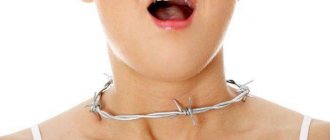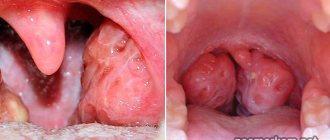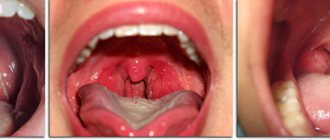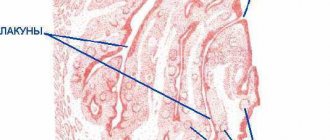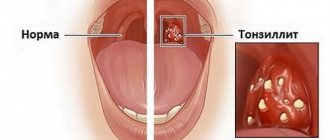If a person has a history of a diagnosis of “chronic tonsillitis,” then such a patient knows firsthand what plugs in the throat, or more precisely in the tonsils, are.
Pus plugs are one of the tonsillitis manifestations of inflammation of the tonsils. They represent an accumulation of remnants of the vital activity of bacteria and leukocytes that died in the fight against them. They also contain phosphorus, calcium and ammonia.
If you look at the palatine tonsil, its surface appears smooth. But in fact, each tonsil is permeated through and through with narrow winding canals - crypts, which end on the surface of the tonsils with openings - lacunae. It is these tortuous crypts and lacunae that become the site of bacterial dislocation and the formation of purulent accumulations. In healthy palatine tonsils, the self-cleaning function works well, which allows you to independently remove the contents of the lacunae. Inflamed tonsillitis glands cannot cope with this function. In chronic tonsillitis, plugs accumulate and cause discomfort. The medical name for tonsillitis plugs is caseous detritus. Their size usually varies from one millimeter to several centimeters. There may be several such clusters in the tonsil, but there are cases when plugs dot the entire surface of the tonsils.
Why do plugs form in the throat?
The main cause of traffic jams is considered to be chronic tonsillitis. Some patients, having fallen ill with a sore throat (or acute tonsillitis), neglect qualified medical care, take medications uncontrollably, complete a course of antibiotics ahead of time, or do nothing at all in the hope that everything will go away on its own. As a result, a chronic disease develops, the consequence of which is the formation and deposition of caseous detritus in the tonsils.
Chronic tonsillitis is a disease in which periods of exacerbation are followed by a resting stage, when the sore throat does not bother the patient for some time.
But in moments of exacerbation, the symptoms, and with them the traffic jams, return.
The formation of purulent accumulations can also be provoked by:
- injuries and mechanical damage to the tonsils (for example, due to hard or tough food, bones accidentally falling into the throat, etc.);
- acute infectious diseases, such as purulent types of tonsillitis, also occur with the formation of tonsillitis plugs;
- anatomical features of the structure of the palatine tonsils - there are cases when the lacunae of a person’s tonsils are enlarged, and this is the norm for him. In such tonsils, the self-cleaning process is difficult, which leads to the accumulation of purulent masses in their thickness.
Indirect causes of traffic jams also include bad habits, poor environment, deviated nasal septum, dental problems - all these factors weaken the body’s defenses and lead to the formation of foci of infection.
Signs of a blockage in the throat.
To diagnose tonsillitis plugs in yourself, you do not need a medical education: they are visible if you look in the mirror and open your mouth wide. Their appearance (if we are talking about chronic tonsillitis) coincides with the beginning of an exacerbation of the disease. But other signs also indicate the presence of caseous detritus in the lacunae of the tonsils.
- Bad breath.
- A sore throat
- Discomfort while swallowing.
- Thickening of the palatine arches.
- The surface of the tonsils becomes loose, adhesions and scars appear.
- Increase in body temperature to 37.5℃.
- Sensation of the presence of a foreign body in the throat (if the plugs are large).
- Malaise, weakness.
Caseous masses are pus, and pus tends to smell extremely unpleasant. Moreover, this smell is felt not only by the patient, but also by those around him. It is this symptom that brings many patients to the otolaryngologist’s office to remove blockages from their throat.
All these symptoms are a good reason to contact an ENT doctor to carry out comprehensive treatment of tonsillitis, including drug therapy, removal of tonsillitis plugs and physiotherapeutic procedures.
Removal with a cotton swab
This procedure should begin an hour and a half after eating in a well-lit room. To reduce the risk of tonsil infection, you should brush your teeth, rinse your mouth, and be sure to wash your hands, wiping them afterwards with a dry paper towel. Then you can proceed with the following actions:
- We stand in front of the mirror and pull the edge of the cheek on the desired side.
- Using a sterile cotton swab, gently press on the anterior palatine arch (or on the area of the base of the tonsil).
- Slowly move the tampon to the top of the tonsil, trying to squeeze the plug out of the lacuna.
- Once the cork is visible, lightly pry it with a cotton swab and remove it.
IMPORTANT. It is strictly forbidden to squeeze out plugs with your fingers, as this can lead to injury (with nails) and infection in the oral cavity.
If attempts to remove plugs on your own cause pain, you should stop immediately and consult a doctor as soon as possible.
Treatment methods for chronic tonsillitis
Chronic inflammation of the palatine tonsils in the early stages is treated conservatively, of course, under the supervision of an otolaryngologist. Only an ENT doctor, after an examination and confirmation of the diagnosis, can prescribe an effective treatment regimen and carefully remove plugs, which will significantly increase the remission stage and make you forget about the symptoms of the disease for a long time.
Drug therapy includes:
- a course of taking antibacterial drugs (“Azithromycin”, “Augmentin”, “Summamed”, etc.);
- treatment of the tonsils with antiseptic drugs (Lugol);
- taking antihistamines to relieve swelling of the mucous membranes (Claritin, Zodak, etc.);
- gargling with antiseptics (“Miramistin”, “Chlorhexidine”, “Furacilin”);
- irrigating the pharynx with anti-inflammatory sprays (Ingalipt, Hexoral).
Among the traditional medicine recipes in the fight against inflamed tonsils, gargling with herbal decoctions (sage, chamomile, St. John's wort) and inhalation, where decoctions of the same medicinal herbs are used as a solution, have proven themselves to be effective.
Friends! Timely and correct treatment will ensure you a speedy recovery!
Physiotherapeutic procedures that are carried out in the ENT clinic help to consolidate the positive effect of drug therapy and speed up the healing process: laser therapy, ultraviolet irradiation, vibroacoustic effects, etc.
Make an appointment right now!
Call us by phone or use the feedback form
Sign up
Folk remedies can be used in parallel with prescribed therapy (but not instead!) and only in consultation with an ENT doctor.
Only an ENT doctor should remove one or another drug from the treatment regimen or add a new one. Self-medication is unacceptable: many cases have been recorded where improper treatment of inflamed tonsils led to complications in other human organs and systems: complications in the heart, kidneys and joints.
I would like to dwell in more detail on how to properly remove traffic jams.
Use of antibiotics
Antibiotics are prescribed in case of purulent processes in the tonsils in order to stop the further spread of infection. As a rule, the drug is selected after taking a smear from the tonsils and determining the sensitivity of the bacteria living in it to certain drug substances. The use of penicillin antibiotics (ampicillin, amoxiclav) is often recommended.
Sometimes the analysis is not carried out, and in this case broad-spectrum drugs belonging to the group of cephalosporins (ceftriaxone, suprax) or macrolides (sumamed, azithromycin) are prescribed. They are used as prescribed orally, administered locally to the tonsils or for inhalation.
Removing tonsillitis plugs: how to remove them correctly?
Removal of caseous masses from the lacunae of the palatine tonsils is the most important part of the treatment of chronic tonsillitis, which should be carried out by an experienced ENT doctor in the clinic. Many patients mistakenly believe that they can remove the purulent contents of the tonsils on their own. A wide variety of items are used: from spoons and matches to toothpicks. Some people manage to remove traffic jams with cotton swabs or their tongue. But we strongly do not recommend resorting to such measures. Attempts to pick out purulent plugs can result in damage to the delicate tissues of the tonsils and infection of the wounds, since rarely do any patients observe proper sterility standards during the procedure.
Modern ENT clinics offer two ways to get rid of plugs: rinsing the palatine tonsils with a syringe and rinsing the palatine tonsils using the Tonzillor apparatus. Removing plugs with a syringe is done less and less often: this method is traumatic and does not allow you to fully wash the tonsils.
The second method is considered the most effective. The nozzle of the Tonsillor device is brought to the tonsil and, like a vacuum cleaner, draws out the purulent contents of the tonsils into the nozzle cup. True, due to the fact that the nozzle cup is opaque, the ENT doctor does not always see whether the tonsils are completely washed - so he has to carry out several additional procedures to remove the caseous masses for sure.
"Doctor Zaitsev's ENT Clinic" offers a third method: removing plugs using a modified attachment of the "Tonsillor" device.
There are no analogues of such a nozzle in any of the Moscow clinics, since it is a unique development of the founder of the “ENT Clinic of Doctor Zaitsev” - Vladimir Mikhailovich Zaitsev and his colleagues.
The improved nozzle is much more convenient than its predecessor. Its rounded edges do not injure the tissue of the tonsils, which sometimes happens with a conventional nozzle, and the transparent cup of the nozzle, into which the contents of the lacunae are washed out, immediately helps the doctor understand when the procedure can be completed without conducting unnecessary sessions. Thereby saving the patient time and money. The attachment can be used even when treating small patients - its small size is ideal for children.
About the goals and features of therapy
The treatment procedure under consideration is aimed not only at cleansing the tonsils from accumulations of purulent formations. The goals of washing the lacunae of the palatine tonsils are also:
- stopping the development of colonies of infectious pathogens;
- relieving vasospasm of the tonsils;
- reduction of the inflammatory process;
- elimination of painful sensations;
- acceleration of recovery.
Washing the depressions in the accumulations of lymphoid tissue is indicated not only for adults, but also for young patients. The method is recognized as a very effective means of preventing:
- Chronic pharyngitis
. Plaque is removed using herbal decoctions. - Peritonsillar abscess
. The tonsils are washed with antiseptics (Furacilin, Chlorhexidine). - Sore throats
(acute, chronic forms). For cleansing, salt and soda solutions and the drug Rotokan are used.
Washing procedures are carried out both in medical clinics and at home. In the latter case, the patient must first consult with a doctor. The specialist will help you choose a solution for rinsing, taking into account the individual condition of the patient and the course of his illness, and will tell you about the features of washing the lacunae of the tonsils at home.
Surgical methods of treatment
The decision to remove tonsils is not made very often. And it is impossible to simply perform an operation at the request of the patient. The time has passed when tonsils were removed for prophylaxis, so that sore throats would no longer bother you. Modern otorhinolaryngologists call for fighting for such an important organ of the immune system as the palatine tonsils, and trying to be treated conservatively. In cases where treatment does not help, a decision is made about surgery. To carry it out, a number of indications are required:
- more than four cases of sore throat per year;
- bad rheumatic tests;
- a peritonsillar abscess that has occurred;
- development of complications on the heart, kidneys and joints.
If the indications for removal are one hundred percent, the patient will be offered several methods of performing the operation: using a scalpel, shaver, laser, cryodestruction or electrocoagulation. An otolaryngologist will tell you in detail about the advantages of each method.
Tongue squeezing
This method is not particularly effective and makes it possible to get rid of only small plugs located on the surface itself and only for a while. But it is the simplest, safest and consists of the following steps:
- Using tongue movements, we try to loosen the cork.
- Using the surface of the tongue, press on the base of the tonsil and palatine arch.
- Squeeze the plug into the mouth and remove it.
If several attempts are unsuccessful, this method should be abandoned.
Rinse
Local antiseptics used for rinsing have not only antibacterial, but also anti-inflammatory and analgesic effects. So, for the treatment of tonsillitis plugs, doctors recommend the following remedies:
Miramistin
For rinsing, use a 0.01% solution of Miramistin. A single dosage is 10-15 ml of the product (or 1 tablespoon), it does not need to be diluted with water. Directions for use: 30-40 minutes after eating, pour Miramistin solution into the mouth and gargle for 1-2 minutes, then spit out the product. Perform at least 4-5 times a day. The course of treatment is 10 days.
Furacilin
To prepare 200 ml of solution you need:
- Grind two Furacilin tablets to a powder (with a mortar or spoon).
- Pour the resulting powder into a glass and add 200 ml of warm water.
- After waiting for complete dissolution, mix and strain through cheesecloth.
Gargle up to 6-7 times a day, using the entire single portion of the product (200 ml). Course of treatment: 7-10 days.
Chlorhexidine
A 0.05% solution is suitable for rinsing. Before the procedure, it is recommended to first rinse your throat with warm water. Then gargle with Chlorhexidine for 30 seconds (single dosage: 1 tbsp). Do not eat or drink anything for the next hour. Perform the procedure 3-4 times a day for 5-7 days.
Soda-salt solution
To prepare the product you will need:
- Dissolve 1 tsp in a glass of warm water (approximate temperature 38-40 degrees). salt and baking soda.
- To increase efficiency, you can add a couple of drops of iodine.
Rinse up to 5-6 times a day. During and after the procedure, a slight burning sensation in the throat is possible. Approximate course of treatment: 7-10 days.
Note! In addition to rinsing, to increase the effectiveness of therapy, you can lubricate the inflamed tonsils with Lugol's solution 2-3 times a day (for example, using a cotton swab). The drug stops the spread of infection and facilitates easier separation of purulent plugs
Washing the lacunae of the tonsils
This method is considered the most effective for removing not only caseous plugs, but also purulent accumulations. It can be carried out:
- Using a syringe. An antiseptic solution is drawn into a sterile syringe, after which a special attachment (thin and curved) is put on it instead of a needle. It is this that is injected into the gaps (the 2-3 largest ones) and the pressure of the antiseptic washes out purulent and other contents from there.
- Vacuum device. Before the procedure, the mucous membrane of the tonsils is anesthetized (usually with lidocoine). Then a “cup” that fits tightly to the surface is placed above the tonsil, after which negative pressure is created using a vacuum, which removes the contents from the lacunae. After the procedure, an antiseptic solution is introduced to prevent the formation of new plugs.
Typically, such treatment is carried out in a course (10-15 procedures every other day).
Laser sealing of gaps
This most modern method allows you to get rid of tonsil blockages forever. Its action is aimed at literally burning out infected tissue and purulent contents from lacunae through the use of a special laser. As a result of the procedure, scars are formed on the tonsils, tightly “sealing” the walls of the lacunae, preventing the infection from getting there again.
The duration of the procedure is about twenty minutes. In some cases, the procedure may need to be repeated up to three times. Within seven to ten days after the manipulation, pain is possible in the area where the laser is applied.
Physiotherapy
The main goal of physiotherapeutic procedures is to remove purulent plugs and reduce inflammation and prevent the progression of the disease.
IMPORTANT. Physiotherapy is contraindicated during periods of exacerbation!
The main physiotherapeutic methods in the treatment of tonsil plugs are:
- Laser irradiation. Helps improve blood and lymph in the area of inflammation, while providing an antimicrobial effect. A painless procedure that lasts no more than five minutes. Typically, the course of treatment consists of six procedures.
- Ultraviolet irradiation. The procedure has a destructive effect on bacteria, due to which inflammation subsides and the protective properties of the tonsils increase. Treatment duration is 10-15 procedures.
- Ultrasonic aerosols. They allow you to direct the necessary medications to hard-to-reach places (deep into the lacunae) using an ultrasound device, significantly increasing their effectiveness. The duration of the course of treatment is determined by the doctor.
